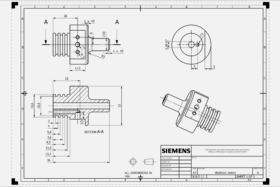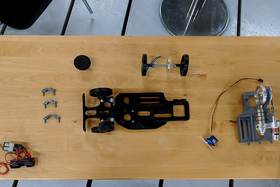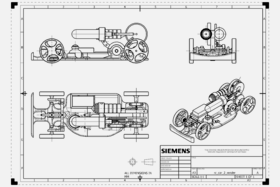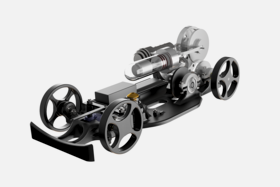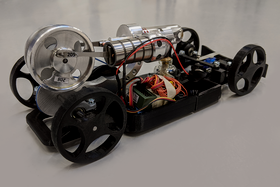
In the Machine Design Project course, students were introduced to the Stirling Engine: a combustion engine from 1816. This engine, a scale model for educational purposes, is very weak and its power (about 4 watts), could be compared to that of a pocket fan. Normally these kinds of engines, interesting for their mechanical and thermo-dynamical aspects, need to be the size of a room to have any meaningful power output.
For their group assignment, students Felipe Gálvez Avalos, Ville Närvänen, Miko Sutinen, Christian Ranta and Daniele Vanerio challenged themselves by pushing this weak and limited engine to the edge of its capacity and were open to learning from possible failure. With the construction of a remote control (RC) car, they could illustrate self-sustaining motion and test if the engine was able to move.
By using a 3D printer to create the prototype, the students had the freedom to develop a structure with an aerodynamic look. They supported the engine made from light-weight material, enabling their creation to work. After the engine had warmed up the RC car exceeded all expectations from professors and peers alike and was able to move through the classroom.
Närvänen says that new technologies like 3D printing create opportunities within engineering that weren’t possible in the past, ‘Because of these characteristics, like the limited weight and ability to create geometries that weren’t possible to construct before, we can rethink, reconstruct, and re-value systems and inventions from the past’. These technologies thus create new approaches to systems improvement and efficiency and challenge the revisiting of anything that has been constructed previously.
‘The RC car itself is a lot of fun to play with and could be an exciting toy for engineering students’, says Avalos. The team also thinks that this addition to the commonly used small scale Stirling engine is more fun, illustrative, and effective for other engineering students.
Many thanks to:
Sven Bossuyt and Kevin Otto
ADDLAB
Mechatronics Lab
Ville Närvänen, Miko Sutinen, Christian Ranta, Felipe Gálvez Avalos (Erasmus Exchange student from Chile), Daniele Vanerio (Erasmus Exchange student from Italy)
Aalto University School of Engineering
Mechanical engineering
Stirling Engine RC-car
Near futures – online exhibition
Near futures, exhibition tribute to the academic year 2019–2020 graduates









